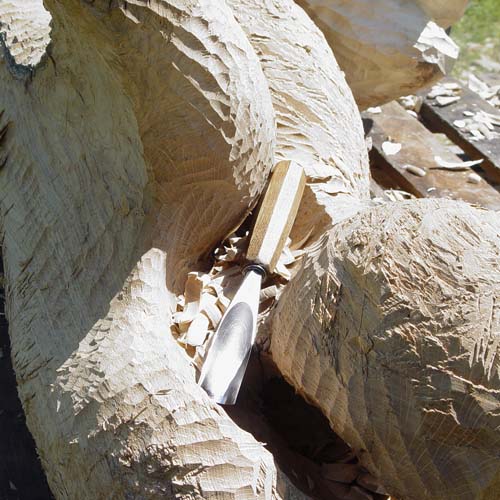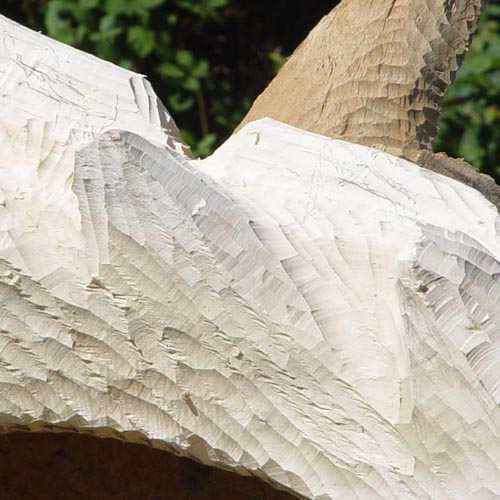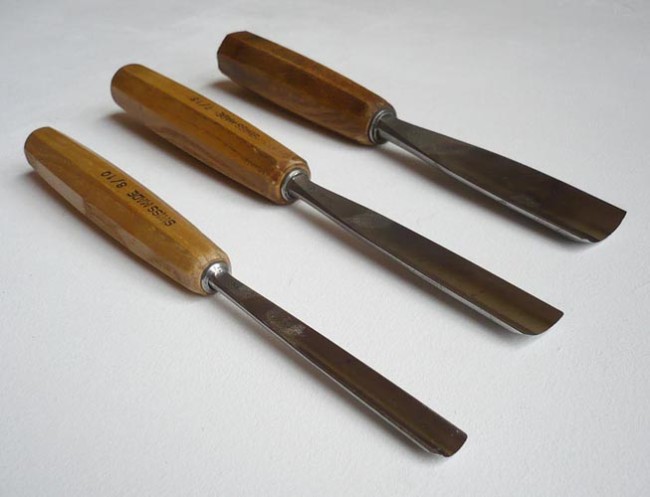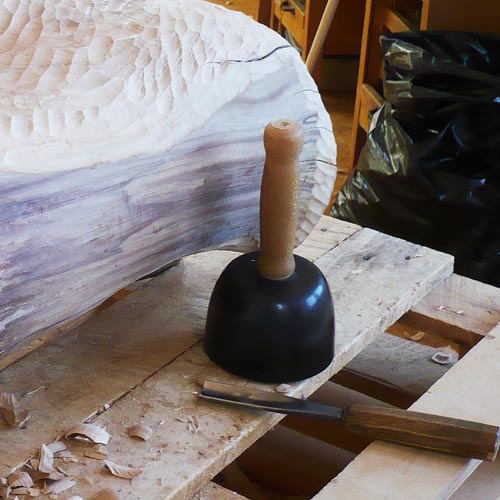 Some people keep the rough surface of the hatchet work. You can get pretty fine with it or leave it rough-cut. That makes the whole process a lot shorter! But I happen to like smooth surfaces, so I need to take the next steps one after the other, sometimes iterating between them several times.
Some people keep the rough surface of the hatchet work. You can get pretty fine with it or leave it rough-cut. That makes the whole process a lot shorter! But I happen to like smooth surfaces, so I need to take the next steps one after the other, sometimes iterating between them several times.
Switching from hatchet to gouge and mallet is always tricky for me, because the way of working is so different. Gouges work in line with the fibers and usually cut into the wood in the direction if the core. Cutting outwards can sometimes work with dry and very fine-grained wood (e.g. beech). But it produces rougher surfaces because the blade cuts against the fibre. And in the worst case it can brake parts – large splinters – out of the wood, that I didn’t intend to brake off. Its safer to work towards the core, but sometimes the form gives me no chance.
Gouges come in a huge variety of forms. They differ in blade width and sweep. Depending on the surface I want to achieve I use specific gouges. On a convex surface the less profiled gouges are good. They keep on the surface and take away only small bits of material. The stronger a gouge is profiled, the deeper I can get into the wood with it. Broader gouges are useful with softer wood or lower amounts of material. If I want to take away a lot of depth, I use narrower ones especially if the would is hard, otherwise I would risk to break the gouge (see ‘connection’).
The first two sculptures I made entirely with one gouge. It is 25 millimetre wide and has a sweep of 8 millimetre depth. It’s a universal tool for nearly everything and is still my favourite, the one I work with most. The others come into play, when this one can’t do it.
The rule about a loose grip on the handles of gouge and mallet applies here as well. The grip on the gouge only gives the direction. The grip on the mallet gives it the impulse and then lets it do the work. If you hold on tight to it during the hit: same result as with the hatchet, just in both arms and shoulders at the same time.
Gouges produce a structured surface of little dents that look like stripes, long or short depending on how you angle the gouge, broader or narrower, deeper or flatter depending on the from of the blade. Maybe they can be compared to brush strokes in a painting. They clearly have a direction and give the surface a dynamic that the hatchet surface doesn’t have. But therein also lies a challenge.
If I have a surface that moves towards the core and outwards again, I work from both sides and try to make them meet at the middle. But the last bit in the centre sometimes seems impossible. That’s what I admire about the work of some great wood sculptors: They make these two movements and gouge structures meet seamlessly and you can’t see any break at any point. Whereas I often end up shaping this middle part by working sideways, which produces an area of dents that cuts right across  the two other structures. Not something you want when trying to achieve a flowing surface.
the two other structures. Not something you want when trying to achieve a flowing surface.
Maybe that’s part of why I usually gofor smoothing the surface completely. There are two advantages of a gouge structure finish that I loose: the dynamic of the ‘strokes’ and the impression you get, when the light plays on this more diverse surface. The form is somehow more concrete, because the eye gets more ‘information points’ from the different angles of the curved surfaces of the dents. It is very expressive in its character. Think of a lake with these ripples caused by a light breeze compared to a smooth-as-glass surface when its still.
But I also love the smooth flow of a surface that has been taken down to grinding status. It is as if my hand already knows what it would feel like, when I run it over the finished sculpture. And every time I do it in one of the other tool stages, something disturbs me.


